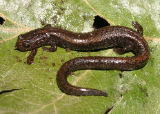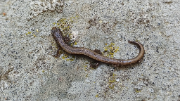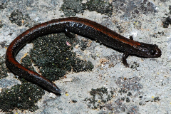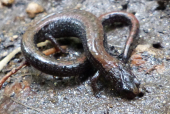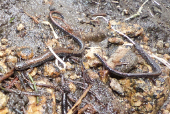Relictual Slender Salamander (Batrachoseps relictus)
Description: Adults are 1 3/8 to 1 7/8 inches long from snout to vent. A small slim salamander with 16 to 20 costal grooves. Short limbs, a long slender body with a narrow head and a long tail, and conspicuous costal and caudal grooves give this species the worm-like appearance typical of most Slender Salamanders. There are four toes on the front and hind feet, which is also typical of Slender Salamanders. (Other California salamanders have five toes on the hind feet.) Color is blackish brown with a reddish, yellowish, or dark brown dorsal stripe which is often not visible in large animals.
Habitat: Associated with seepages and springs in rocky areas with scant tree cover consisting mostly of oaks with scattered pines and buckeyes and sycamores in creek bottoms. Rarely found far from surface water.
Range: Endemic to California.Historically, salamanders now known as B. relictus occured only in a small range from the south side of the Kern River in the Lower Kern River Canyon, to a few locations on Breckenridge Mountain. But the lower Kern River Canyon populations have apparently been extirpated, making the species now a Breckenridge Mountain endemic, currently known from only two locations separated by 3.1 miles. This makes the known range for this species the smallest of any slender salamander species.
Found in these States:
CA
Diet: Most likely eats a variety of small invertebrates. Feeding behavior is not well known, but other Batrachoseps species are sit-and-wait predators that use a projectile tongue to catch prey.
Reproduction: Little is known yet of the life history of this species. It is presumed that it is similar to other slender salamanders which reproduct terrestrially, lay eggs in moist places on land, and the young develop completely in the egg and hatch fully formed.
Reproduction is terrestrial.
Status: Listed as Critically Endangered because its estimated extent of occurrence (EOO) is 32 km2, it occurs in one threat-defined location, and there is continuing decline in the extent and quality of its habitat in the Breckenridge Mountains due to the impacts of climate change, drought-induced wildfires, and timber harvesting.
»» Kingdom: Animalia - Animals
»» Phylum: Chordata - Chordates
»» Subphylum: Vertebrata - Vertebrates
»» Class: Amphibia - (Amphibians)
»» Order: Caudata - Salamanders
»» Family: Plethodontidae - Lungless Salamanders
»» Genus: Batrachoseps
»» Species: Batrachoseps relictus - Relictual Slender Salamander
This article uses material from the Wikipedia article "Relictual Slender Salamander", which is released under the Creative Commons Attribution-Share-Alike License 3.0. Content may have been omitted from the original, but no content has been changed or extended.
|




